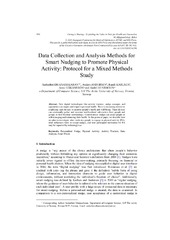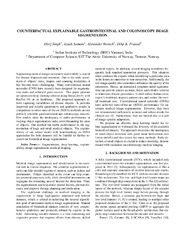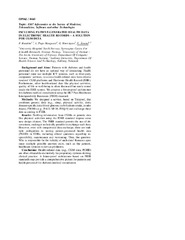Institutt for informatikk: Nye registreringer
Viser treff 241-260 av 769
-
Exploring the Challenges of a Flexible, Feature Rich IoT Testbed
(Mastergradsoppgave; Master thesis, 2023-05-15)IoT is a field of technology of ever growing importance in our daily lives. From smart cities, health devices, climate observations, appliances, and so much more, IoT surrounds us now more than ever. The types of devices being added to IoT networks is ever growing, and as this variety of hardware and software increases, so does the difficulty of working with them. Ensuring inter-compatibility between ... -
Multi-site multi-synchronous support for SQLite augmented for Local- First Software
(Mastergradsoppgave; Master thesis, 2023-05-12)At the one end of the spectrum, locally installed applications allow users to work offline and at their convenience but do not support collaboration among multiple users or devices. At the other end, cloud-based applications offer collaboration and data synchronization but require an uninterrupted internet connection. To address these limitations, Local-First software was introduced to merge the ... -
Dárkon
(Mastergradsoppgave; Master thesis, 2023-05-22)Sports today are more competitive than ever, with an eye for extreme details. Small margins can differentiate between succeeding or failing. That is why it is essential for a team to pay attention to all these margins and use them to their advantage. Technology today plays a huge part in sports. With video cameras and sensors following the players’ every move, it is vital to use this technology ... -
Tram-tastic Cloud Computing
(Mastergradsoppgave; Master thesis, 2023-05-14)This master’s thesis evaluates the scalability and cost-effectiveness of the AWS cloud platform used to collect and utilize data generated by the 87 digitally equipped trams. The SL-18 Cloud Platform was developed before the trams arrived, and resource configuration estimates were made to handle the data generated by the trams. However, with a few trams currently operational, it is crucial to evaluate ... -
ZeroComm: Decentralized, Secure and Trustful Group Communication
(Mastergradsoppgave; Master thesis, 2023-05-15)In the context of computer networks, decentralization is a network architecture that distributes both workload and control of a system among a set of coequal participants. Applications based on such networks enhance trust involved in communication by eliminating the external author- ities with self-interests, including governments and tech companies. The decentralized model delegates the ownership ... -
Sneak
(Mastergradsoppgave; Master thesis, 2023-05-15)Secure multiparty computation (SMC) is a technique that allows multiple parties to jointly compute a function while keeping their inputs private. This technique has gained significant attention due to its potential applications in various fields, including privacy-preserving healthcare, politics and finance. SMC involves a set of protocols that enable parties to achieve secure computation and ... -
Presenting CODS (Cell Organelle Dynamic Simulation)
(Master thesis; Mastergradsoppgave, 2023-05-15)The interactions between organelles within living cells have an effect on the health of the organism [1]. One way to study this behavior is to develop algorithms which can automatically detect and track objects in microscopy video data. A large amount of data is needed to train algorithms to identify particular behaviors in subcellular machinery. If the case of segmentation is considered, videos of ... -
Quantifying athlete wellness: Investigating the predictive potential of subjective wellness reports through a player monitoring system
(Journal article; Tidsskriftartikkel; Peer reviewed, 2023-05-25)This study investigated the potential of self-reported wellness data from a player monitoring system and its predictive power of individual match performance among a female professional football player cohort. Using longitudinal data collected from the Pm Reporter Pro mobile application and corresponding individual performance scores (InStat Index), the study investigated if pre-match perceived ... -
Health research requires efficient platforms for data collection from personal devices
(Journal article; Tidsskriftartikkel; Peer reviewed, 2023)Data from consumer-based devices for collecting personal health-related data could be useful in diagnostics and treatment. This requires a flexible and scalable software and system architecture to handle the data. This study examines the existing mSpider platform, addresses shortcomings in security and development, and suggests a full risk analysis, a more loosely coupled component- based system for ... -
Data collection and analysis methods for smart nudging to promote physical activity: Protocol for a mixed methods study
(Journal article; Tidsskriftartikkel; Peer reviewed, 2023)New digital technologies like activity trackers, nudge concepts, and approaches can inspire and improve personal health. There is increasing interest in employing such devices to monitor people’s health and well-being. These devices can continually gather and examine health-related information from people and groups in their familiar surroundings. Context-aware nudges can assist people in self-managing ... -
Capturing Nutrition Data for Sports: Challenges and Ethical Issues
(Conference object; Konferansebidrag, 2023-01)Nutritionplaysakeyroleinanathlete’s performance, health, and mental well-being. Capturing nutrition data is crucial for analyzing those relations and performing necessary interventions. Using traditional methods to capture long-term nutritional data requires intensive labor, and is prone to errors and biases. Artificial Intelligence (AI) methods can be used to remedy such problems by using Image-Based ... -
Using machine learning to provide automatic image annotation for wildlife camera traps in the Arctic
(Chapter; Bokkapittel, 2017)The arctic tundra is considered the terrestrial biome expected to be most impacted by climate change, with temperatures projected to increase as much as 10 °C by the turn of the century. The Climate-ecological Observatory for Arctic Tundra (COAT) project monitors the climate and ecosystems using several sensor types. We report on results from projects that automate image annotations from two of the ... -
Prototyping a Diet Self-management System for People with Diabetes with Cultural Adaptable User Interface Design
(Chapter; Bokkapittel, 2014-08-22)Diet management is a critical part of diabetes selfmanagement. This project developed a working prototype application on Android-based mobile phone called SMART CARB that assists people with diabetes to self-manage their diet. The system particularly focused on monitoring carbohydrate intake in order to control their blood glucose levels. The project was positioned as a research extension to the ... -
Counterfactual Explainable Gastrointestinal and Colonoscopy Image Segmentation
(Journal article; Tidsskriftartikkel; Peer reviewed, 2022-04-26)Segmenting medical images accurately and reliably is crucial for disease diagnosis and treatment. Due to the wide assortment of objects’ sizes, shapes, and scanning modalities, it has become more challenging. Many convolutional neural networks (CNN) have recently been designed for segmentation tasks and achieved great success. This paper presents an optimized deep learning solution using DeepLabv3+ ... -
A Self-Configuration Controller To Detect, Identify, and Recover Misconfiguration At IoT Edge Devices and Containerized Cluster System
(Journal article; Tidsskriftartikkel; Peer reviewed, 2023)Securing workloads and information flow against misconfiguration in container-based clusters and edge medical devices is an important part of overall system security. This paper presented a controller that analyzes the misconfiguration, maps the observation to its hidden misconfiguration type, and selects the optimal recovery policy to maximize the performance of defined metrics. In the future, we ... -
Including patient-generated health data in electronic health records – a solution for CGM-data
(Journal article; Tidsskriftartikkel; Peer reviewed, 2023)Patients with diabetes and health personnel do not have an optimal way of interacting. Health personnel must use multiple ICT systems, such as third-party companies’ services, to access health-related data from diverse vendors’ CGM platforms and Electronic Health Record (EHR). Furthermore, other health-related data like physical activities, quality of life or well-being is often discussed but ... -
Technical Viewpoint of Challenges, Opportunities, and Future Directions of Policy Change and Information-Flow in Digital Healthcare Systems
(Chapter; Bokkapittel, 2022)Digital healthcare systems often run on heterogeneous devices in a distributed multi-cluster environment, and maintain their healthcare policies for managing data, securing information flow, and controlling interactions among systems components. As healthcare systems become more digitally distributed, lack of integration and safe interpretation between heterogeneous systems clusters become ... -
Automatic thumbnail selection for soccer videos using machine learning
(Chapter; Bokkapittel, 2022-08-05)Thumbnail selection is a very important aspect of online sport video presentation, as thumbnails capture the essence of important events, engage viewers, and make video clips attractive to watch. Traditional solutions in the soccer domain for presenting highlight clips of important events such as goals, substitutions, and cards rely on the manual or static selection of thumbnails. However, such ... -
Predicting Tacrolimus Exposure in Kidney Transplanted Patients Using Machine Learning
(Journal article; Tidsskriftartikkel; Peer reviewed, 2022-08-31)Tacrolimus is one of the cornerstone immunosup-pressive drugs in most transplantation centers worldwide following solid organ transplantation. Therapeutic drug monitoring of tacrolimus is necessary in order to avoid rejection of the transplanted organ or severe side effects. However, finding the right dose for a given patient is challenging, even for experienced clinicians. Consequently, a tool that ... -
DoubleU-Net: A Deep Convolutional Neural Network for Medical Image Segmentation
(Journal article; Tidsskriftartikkel; Peer reviewed, 2020-09-01)Semantic image segmentation is the process of labeling each pixel of an image with its corresponding class. An encoder-decoder based approach, like U-Net and its variants, is a popular strategy for solving medical image segmentation tasks. To improve the performance of U-Net on various segmentation tasks, we propose a novel architecture called DoubleU-Net, which is a combination of two U-Net ...


 English
English norsk
norsk


















